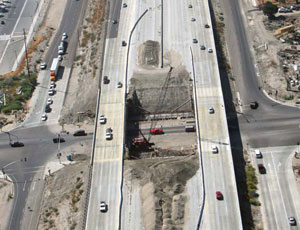
“This double investment of stimulus and Prop 1B will payoff with jobs sorely needed in the region,” says Caltrans’ Randell Iwasaki. “But it is also critical for the area’s economic growth and sets the foundation for the city’s revitalization plans.”
Phase 3 of the project will improve access to the east and west sides of the city, improve safety with the elimination of fast-lane ramps, improve traffic flow with the use of braided ramps, improve air quality and reduce noise. In addition, the increased capacity will reduce congestion and improve mobility. Phase 4 will add direct connectors to SR-210.
Construction on Phase 1, which reconstructed the Fifth Street Bridge, was led by SANBAG. It began in February 2007 and was completed in February 2008. Construction on Phase 2, led by Caltrans, began in December 2007 and is scheduled to be completed in mid-2010.
Phase 2 is widening I-215 from just north of I-10 to Rialto Avenue from three lanes to five, adding new on- and off-ramps, widening Mill Street, and constructing a new bridge at Inland Center Drive.
Full construction activity on Phase 3, led by SANBAG, will be underway in October 2009, and Phase 4, led by Caltrans, will start shortly thereafter. Both phases will be completed in late 2013.
The entire project starts on the I-215 from just north of I-10 to University Parkway. Phases 3 and 4 will continue the widening of I-215 from Rialto Avenue to University Parkway. They include 17 new bridges, new on- and off-ramps, a wider freeway and I-215/SR-210 connector ramps.
The project will greatly ease congestion along a route expected to grow from an estimated 83,000 drivers daily to 130,000 in the next 20 years.
SANBAG is saying that the project, based the ARRA formula, will create 2,000 jobs per year times four years, or 8,000 jobs over the life of the project, says Jane Dreher, public information officer. That is based on the formula from ARRA of 18,000 jobs per $1 billion.
Dreher adds that Skanska says it would create 450 to 600 construction jobs per year, and based on another formula.
Of the $26.6 billion in Recovery Act funds available nationwide for highways, more than 7,000 projects worth more than $18 billion have been obligated. California has obligated $2 billion – or 79 percent – of its $2.6 billion share of the funding available for highways and bridge construction.

Post a comment to this article
Report Abusive Comment